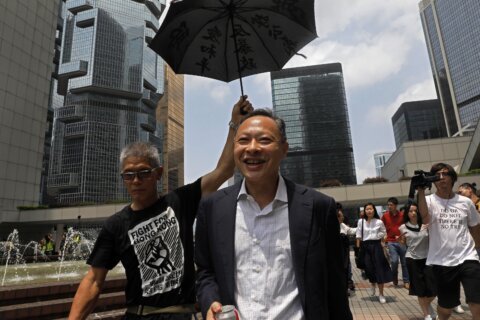If you had the news on for any length of time last weekend, you almost certainly saw the signing of executive actions that President Donald Trump held at his golf club in Bedminster, New Jersey — actions designed to help people who have seen their lives turned upside down due to the pandemic.
The event received a healthy amount of media coverage, but what do the measures mean for ordinary Americans? Because these are executive orders and not laws passed by Congress, will you see improvement in your economic life?
The short answer? It depends. The longer answer? We’ll take a look at how your wallet may be affected, but it impacts four areas of people’s financial lives: payroll tax, unemployment benefits, evictions and student loans.
[Read: How to Pay for Coronavirus Medical Expenses.]
Payroll Taxes
What the executive measure does. This would be a payroll tax delay. If you’re making less than $104,000 a year, your federal tax withholding would be deferred for the remaining months of 2020, which means you’d receive more money in your paychecks.
The good news. Well, that’s easy: You may see bigger paychecks for the rest of the year.
The bad news. This is a deferral and not a tax cut, and so everyone will have to pay those taxes back, without additional interest.
David Gulley, an economics professor at Bentley University in Waltham, Massachusetts, doesn’t sound impressed.
“The intent is to put more money in the pockets of households to support their spending,” he says. “However, these taxes would only be deferred, and if not made permanent, a big tax bill would come due at the beginning of 2021. Knowing this bill might be on the horizon, households may not spend as much of the extra funds as supporters contend.”
He adds that in the past, reductions in payroll taxes or income tax withholding have had mixed impacts on household spending.
It also may be just as well that it is a deferral and not a tax cut. Payroll taxes go toward paying for Social Security and Medicare. A tax cut would arguably weaken both funds down the road.
Small wonder that Peter Nigro, professor of finance at Bryant University in Smithfield, Rhode Island, says: “The payroll tax executive order is silly.”
Unemployment Benefits
What the executive measure does. As part of the $2.2 trillion stimulus package passed earlier this year, unemployed people had been receiving an extra $600 every week from the federal government in addition to their state’s unemployment aid. That ended in July.
Trump stated that his memorandum will give unemployed people “an additional or extra $400 a week and expanded benefits.”
The good news. An extra $400 a week isn’t as much as an extra $600, but every little bit helps, right?
The bad news. The federal government will actually be forking over an extra $300 a week on top of your state benefits if your state agrees to chip in $100. That may be a big ask if your state is particularly pandemic-battered and financially strapped.
There has been talk that perhaps the federal government will offer up $300 extra a week even if states don’t chip in $100.
Meanwhile, many unemployment experts expect it to take a while before states are able to get the additional money in their payment systems, but the money is retroactive to Aug. 1, so at least if it’s September when you get the money, you’ll get all of it.
But Gulley doesn’t suggest you count on getting that $300 or $400 in your bank account.
“The president’s attempt to add $400 per week to unemployment benefits isn’t likely to put much, if any, extra money in the pockets of those who are out of work,” he says. “The funding difficulties, combined with the likelihood of legal challenges, suggest that households shouldn’t count on this money providing much support.”
On top of that, if you do get the extra $300 or $400 a week, it won’t last long. The money will come from the Department of Homeland Security’s $44 billion disaster relief fund. It will either end when that money is depleted or on Dec. 6. In the meantime, if you need additional unemployment aid, you should keep your fingers crossed that Congress passes new legislation to address federal unemployment benefits — and that a natural disaster doesn’t hit the country any time soon.
[See: 35 Ways to Save Money.]
Evictions
What the executive measure does. On Saturday, Trump said, “I’m signing an executive order directing the Department of Housing and Urban Development, HHS and CDC to make sure renters and homeowners can stay in their homes. So I’m protecting people from eviction.”
The good news. The executive order states, “The Secretary of Health and Human Services and the Director of CDC shall consider whether any measures temporarily halting residential evictions of any tenants for failure to pay rent are reasonably necessary to prevent the further spread of COVID-19 from one State or possession into any other State or possession.”
Is this even good news, and will it help you? Well, it might. As noted, the federal government will consider the merits of keeping you in your home. But if that sounds like weak language, it’s because it is. You’ll be hard-pressed to find a housing expert that thinks this is a strong measure to protect people from evictions.
The bad news. This is not a halt on evictions. In March, a moratorium on evictions was passed, included in the $2.2 stimulus law, which meant that you were not allowed to be evicted. Of course, if you’re reading this now and thinking, “But I was evicted,” this was protection on mortgages and mortgages protected by federal funds.
The moratorium ended in July. This executive order doesn’t extend it. It does encourage the federal government to minimize evictions and look for ways to help homeowners and renters.
Will that be enough? Nigro doesn’t think so. “This narrow statement is limited at best in its ability to prevent a tsunami of evictions. Congress would need to create a federal moratorium with appropriated money for rental assistance to have a real impact,” he says.
Virginia Beard is equally skeptical. Beard is an assistant professor of political science at Hope College in Holland, Michigan, and a scholar of poverty and public policy, specifically access to housing and factors causing homelessness.
She gives the executive order credit for recognizing that something needs to be done, but she says, “it does not actually do anything to prevent evictions or foreclosures, nor does it assist homeowners or landlords in any meaningful ways. The president could have extended that moratoria but chose not to do so. Thus, the name of the most recent executive order is mostly smoke and mirrors — it does not provide any tangible assistance to those struggling to maintain their housing.”
She is hopeful that some protection will be offered but says this isn’t it.
“Real legislative — not executive — branch action is needed to both support renters and homeowners as well as landlords to ensure that housing-based economic and public health crises are prevented,” Beard says.
Amber Crowell, an assistant professor of sociology at California State University–Fresno, who studies residential segregation and racial and ethnic inequality, also feels the executive measure doesn’t measure up.
“The president’s executive order did not really change anything about the situation that we are in or what lies ahead,” she says.
“Tens of millions of renters are in imminent danger of eviction as states across the country have mostly lifted their own moratoriums and financial assistance is running out. What the president did was direct certain departments to think about how to use federal funding to give relief to renters and landlords, with more emphasis on landlords. This carries neither urgency nor decisiveness, and does not stop evictions. Without legislation that provides financial relief to renters and landlords and halts eviction proceedings, the wave of evictions is still happening.”
[Read: Preparing Your Finances for a Recession.]
Student Loans
What the executive measure does. The stimulus package passed earlier in the year put a moratorium on having to pay student loans, but that was going to end on Sept. 30. President Trump’s executive action gives borrowers with student debt another three-month break from their bills, during which interest will not accrue. So if you owe money to the federal government for student loans, you don’t have to make another payment until January 2021.
The good news. This is exactly what it sounds like. You can exhale a sigh of relief. If you haven’t been paying federal student loans for a while, your respite can continue.
The bad news. It’s bad news if you have private student loans, which make up a substantial part of the student loan market, Nigro says. In that case, those payments are probably still due. Of this executive order, in general, Nigro says: “Helps some, but not really a game-changer.”
More from U.S. News
Money Moves You Will Be Thankful For
Best Buy and Sell Apps for Used Stuff
What Does Trump’s Executive Order Mean for You? originally appeared on usnews.com







